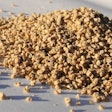A single egg from a laying hen given vitamin D supplemented feed could contribute significantly to the recommended daily intake of vitamin D for both adults and children.
PhD student Linda Browning, supported by the Poultry CRC at the University of Sydney in Australia, has been investigating the efficiency of deposition of vitamin D into egg yolks following supplementation in the feed of laying hens.
Additionally, she has measured the change in vitamin D deposition into egg yolks over time, and the effect that supplementation may have on the overall performance of the hens.
Eggs are one of the few natural food sources rich in vitamin D, and they contain both vitamin D3 and 25-hydroxy D3 (25(OH)D3) metabolites of vitamin D. The latter is especially useful as it provides five times the relative biological activity of vitamin D in the human diet. The research investigated the in-egg vitamin D concentrations resulting from supplementation. The results of the work look promising.
Browning comments: "Overall, D3 content per kilogram of egg yolk increased as the addition of D3 increased. And the higher dietary levels of D3 also significantly increased the 25(OH)D3 content of egg yolk, but not the D3 content of egg yolk."
Additionally, the hens showed a rapid response to vitamin D supplementation in the feed, with a plateauing of total deposition as early as the third week of the trial.
A single egg from a laying hen, supplemented with increased level of D3 and 25(OH)D3, had the potential to contribute significantly to the recommended daily intake of vitamin D for both adults and children without detrimental effect on hen production parameters.
Browning added: "I think it is a most worthwhile story for both egg producers and egg consumers alike. The cost [of] a full dose of vitamin D (10,000 iu + 69 micrograms 25-hydroxy D3) is only about 1 cent per dozen eggs."
The research also demonstrated a wide variation in the inherent vitamin D concentration of egg yolk at day one of the trial, which could not be explained by the diet alone because all birds had consumed the same level of dietary vitamin D prior to commencement of the trial. The most likely cause is the inherent genetic difference between birds in their ability to transfer vitamin D metabolites across their intestinal wall into the yolk.





